Athira Nambiar
Replay to Remember (R2R): An Efficient Uncertainty-driven Unsupervised Continual Learning Framework Using Generative Replay
May 07, 2025Abstract:Continual Learning entails progressively acquiring knowledge from new data while retaining previously acquired knowledge, thereby mitigating ``Catastrophic Forgetting'' in neural networks. Our work presents a novel uncertainty-driven Unsupervised Continual Learning framework using Generative Replay, namely ``Replay to Remember (R2R)''. The proposed R2R architecture efficiently uses unlabelled and synthetic labelled data in a balanced proportion using a cluster-level uncertainty-driven feedback mechanism and a VLM-powered generative replay module. Unlike traditional memory-buffer methods that depend on pretrained models and pseudo-labels, our R2R framework operates without any prior training. It leverages visual features from unlabeled data and adapts continuously using clustering-based uncertainty estimation coupled with dynamic thresholding. Concurrently, a generative replay mechanism along with DeepSeek-R1 powered CLIP VLM produces labelled synthetic data representative of past experiences, resembling biological visual thinking that replays memory to remember and act in new, unseen tasks. Extensive experimental analyses are carried out in CIFAR-10, CIFAR-100, CINIC-10, SVHN and TinyImageNet datasets. Our proposed R2R approach improves knowledge retention, achieving a state-of-the-art performance of 98.13%, 73.06%, 93.41%, 95.18%, 59.74%, respectively, surpassing state-of-the-art performance by over 4.36%.
PRIMEDrive-CoT: A Precognitive Chain-of-Thought Framework for Uncertainty-Aware Object Interaction in Driving Scene Scenario
Apr 08, 2025Abstract:Driving scene understanding is a critical real-world problem that involves interpreting and associating various elements of a driving environment, such as vehicles, pedestrians, and traffic signals. Despite advancements in autonomous driving, traditional pipelines rely on deterministic models that fail to capture the probabilistic nature and inherent uncertainty of real-world driving. To address this, we propose PRIMEDrive-CoT, a novel uncertainty-aware model for object interaction and Chain-of-Thought (CoT) reasoning in driving scenarios. In particular, our approach combines LiDAR-based 3D object detection with multi-view RGB references to ensure interpretable and reliable scene understanding. Uncertainty and risk assessment, along with object interactions, are modelled using Bayesian Graph Neural Networks (BGNNs) for probabilistic reasoning under ambiguous conditions. Interpretable decisions are facilitated through CoT reasoning, leveraging object dynamics and contextual cues, while Grad-CAM visualizations highlight attention regions. Extensive evaluations on the DriveCoT dataset demonstrate that PRIMEDrive-CoT outperforms state-of-the-art CoT and risk-aware models.
Synth-SONAR: Sonar Image Synthesis with Enhanced Diversity and Realism via Dual Diffusion Models and GPT Prompting
Oct 11, 2024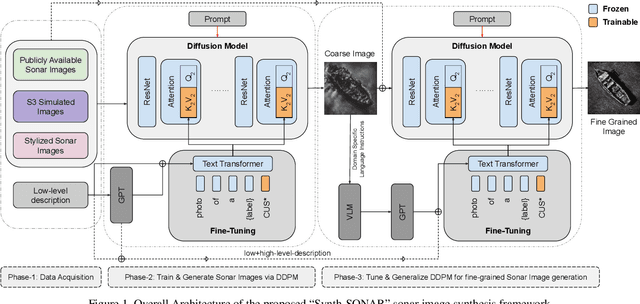
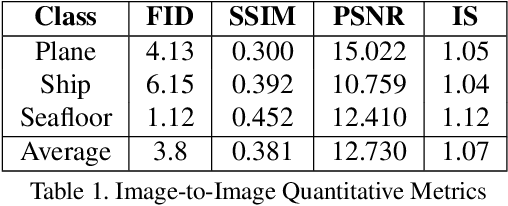
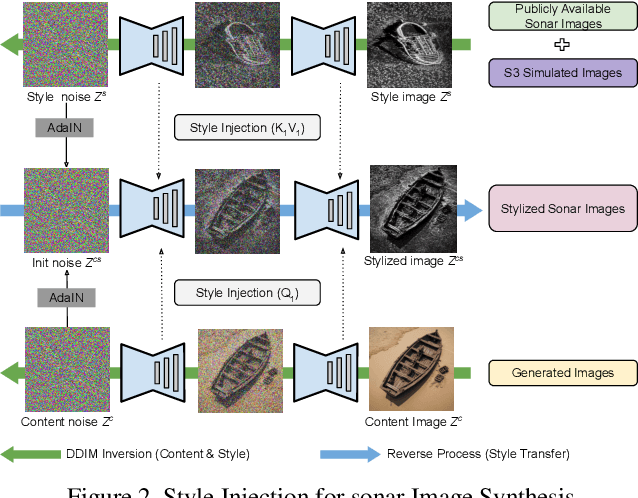

Abstract:Sonar image synthesis is crucial for advancing applications in underwater exploration, marine biology, and defence. Traditional methods often rely on extensive and costly data collection using sonar sensors, jeopardizing data quality and diversity. To overcome these limitations, this study proposes a new sonar image synthesis framework, Synth-SONAR leveraging diffusion models and GPT prompting. The key novelties of Synth-SONAR are threefold: First, by integrating Generative AI-based style injection techniques along with publicly available real/simulated data, thereby producing one of the largest sonar data corpus for sonar research. Second, a dual text-conditioning sonar diffusion model hierarchy synthesizes coarse and fine-grained sonar images with enhanced quality and diversity. Third, high-level (coarse) and low-level (detailed) text-based sonar generation methods leverage advanced semantic information available in visual language models (VLMs) and GPT-prompting. During inference, the method generates diverse and realistic sonar images from textual prompts, bridging the gap between textual descriptions and sonar image generation. This marks the application of GPT-prompting in sonar imagery for the first time, to the best of our knowledge. Synth-SONAR achieves state-of-the-art results in producing high-quality synthetic sonar datasets, significantly enhancing their diversity and realism.
Underwater SONAR Image Classification and Analysis using LIME-based Explainable Artificial Intelligence
Aug 23, 2024Abstract:Deep learning techniques have revolutionized image classification by mimicking human cognition and automating complex decision-making processes. However, the deployment of AI systems in the wild, especially in high-security domains such as defence, is curbed by the lack of explainability of the model. To this end, eXplainable AI (XAI) is an emerging area of research that is intended to explore the unexplained hidden black box nature of deep neural networks. This paper explores the application of the eXplainable Artificial Intelligence (XAI) tool to interpret the underwater image classification results, one of the first works in the domain to the best of our knowledge. Our study delves into the realm of SONAR image classification using a custom dataset derived from diverse sources, including the Seabed Objects KLSG dataset, the camera SONAR dataset, the mine SONAR images dataset, and the SCTD dataset. An extensive analysis of transfer learning techniques for image classification using benchmark Convolutional Neural Network (CNN) architectures such as VGG16, ResNet50, InceptionV3, DenseNet121, etc. is carried out. On top of this classification model, a post-hoc XAI technique, viz. Local Interpretable Model-Agnostic Explanations (LIME) are incorporated to provide transparent justifications for the model's decisions by perturbing input data locally to see how predictions change. Furthermore, Submodular Picks LIME (SP-LIME) a version of LIME particular to images, that perturbs the image based on the submodular picks is also extensively studied. To this end, two submodular optimization algorithms i.e. Quickshift and Simple Linear Iterative Clustering (SLIC) are leveraged towards submodular picks. The extensive analysis of XAI techniques highlights interpretability of the results in a more human-compliant way, thus boosting our confidence and reliability.
S3Simulator: A benchmarking Side Scan Sonar Simulator dataset for Underwater Image Analysis
Aug 23, 2024



Abstract:Acoustic sonar imaging systems are widely used for underwater surveillance in both civilian and military sectors. However, acquiring high-quality sonar datasets for training Artificial Intelligence (AI) models confronts challenges such as limited data availability, financial constraints, and data confidentiality. To overcome these challenges, we propose a novel benchmark dataset of Simulated Side-Scan Sonar images, which we term as 'S3Simulator dataset'. Our dataset creation utilizes advanced simulation techniques to accurately replicate underwater conditions and produce diverse synthetic sonar imaging. In particular, the cutting-edge AI segmentation tool i.e. Segment Anything Model (SAM) is leveraged for optimally isolating and segmenting the object images, such as ships and planes, from real scenes. Further, advanced Computer-Aided Design tools i.e. SelfCAD and simulation software such as Gazebo are employed to create the 3D model and to optimally visualize within realistic environments, respectively. Further, a range of computational imaging techniques are employed to improve the quality of the data, enabling the AI models for the analysis of the sonar images. Extensive analyses are carried out on S3simulator as well as real sonar datasets to validate the performance of AI models for underwater object classification. Our experimental results highlight that the S3Simulator dataset will be a promising benchmark dataset for research on underwater image analysis. https://github.com/bashakamal/S3Simulator.
VALE: A Multimodal Visual and Language Explanation Framework for Image Classifiers using eXplainable AI and Language Models
Aug 23, 2024Abstract:Deep Neural Networks (DNNs) have revolutionized various fields by enabling task automation and reducing human error. However, their internal workings and decision-making processes remain obscure due to their black box nature. Consequently, the lack of interpretability limits the application of these models in high-risk scenarios. To address this issue, the emerging field of eXplainable Artificial Intelligence (XAI) aims to explain and interpret the inner workings of DNNs. Despite advancements, XAI faces challenges such as the semantic gap between machine and human understanding, the trade-off between interpretability and performance, and the need for context-specific explanations. To overcome these limitations, we propose a novel multimodal framework named VALE Visual and Language Explanation. VALE integrates explainable AI techniques with advanced language models to provide comprehensive explanations. This framework utilizes visual explanations from XAI tools, an advanced zero-shot image segmentation model, and a visual language model to generate corresponding textual explanations. By combining visual and textual explanations, VALE bridges the semantic gap between machine outputs and human interpretation, delivering results that are more comprehensible to users. In this paper, we conduct a pilot study of the VALE framework for image classification tasks. Specifically, Shapley Additive Explanations (SHAP) are used to identify the most influential regions in classified images. The object of interest is then extracted using the Segment Anything Model (SAM), and explanations are generated using state-of-the-art pre-trained Vision-Language Models (VLMs). Extensive experimental studies are performed on two datasets: the ImageNet dataset and a custom underwater SONAR image dataset, demonstrating VALEs real-world applicability in underwater image classification.
SegXAL: Explainable Active Learning for Semantic Segmentation in Driving Scene Scenarios
Aug 08, 2024Abstract:Most of the sophisticated AI models utilize huge amounts of annotated data and heavy training to achieve high-end performance. However, there are certain challenges that hinder the deployment of AI models "in-the-wild" scenarios, i.e., inefficient use of unlabeled data, lack of incorporation of human expertise, and lack of interpretation of the results. To mitigate these challenges, we propose a novel Explainable Active Learning (XAL) model, XAL-based semantic segmentation model "SegXAL", that can (i) effectively utilize the unlabeled data, (ii) facilitate the "Human-in-the-loop" paradigm, and (iii) augment the model decisions in an interpretable way. In particular, we investigate the application of the SegXAL model for semantic segmentation in driving scene scenarios. The SegXAL model proposes the image regions that require labeling assistance from Oracle by dint of explainable AI (XAI) and uncertainty measures in a weakly-supervised manner. Specifically, we propose a novel Proximity-aware Explainable-AI (PAE) module and Entropy-based Uncertainty (EBU) module to get an Explainable Error Mask, which enables the machine teachers/human experts to provide intuitive reasoning behind the results and to solicit feedback to the AI system via an active learning strategy. Such a mechanism bridges the semantic gap between man and machine through collaborative intelligence, where humans and AI actively enhance each other's complementary strengths. A novel high-confidence sample selection technique based on the DICE similarity coefficient is also presented within the SegXAL framework. Extensive quantitative and qualitative analyses are carried out in the benchmarking Cityscape dataset. Results show the outperformance of our proposed SegXAL against other state-of-the-art models.
Multimodal Adaptive Fusion of Face and Gait Features using Keyless attention based Deep Neural Networks for Human Identification
Mar 24, 2023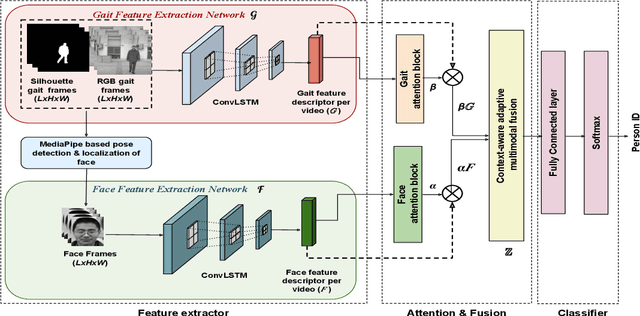
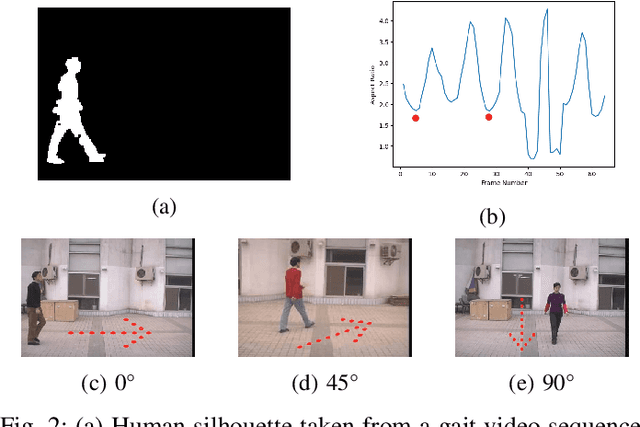

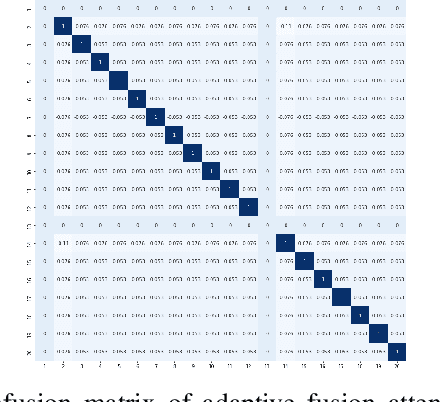
Abstract:Biometrics plays a significant role in vision-based surveillance applications. Soft biometrics such as gait is widely used with face in surveillance tasks like person recognition and re-identification. Nevertheless, in practical scenarios, classical fusion techniques respond poorly to changes in individual users and in the external environment. To this end, we propose a novel adaptive multi-biometric fusion strategy for the dynamic incorporation of gait and face biometric cues by leveraging keyless attention deep neural networks. Various external factors such as viewpoint and distance to the camera, are investigated in this study. Extensive experiments have shown superior performanceof the proposed model compared with the state-of-the-art model.
Co-segmentation Inspired Attention Module for Video-based Computer Vision Tasks
Nov 25, 2021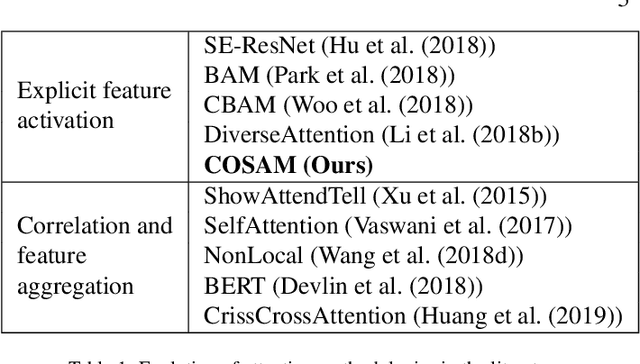
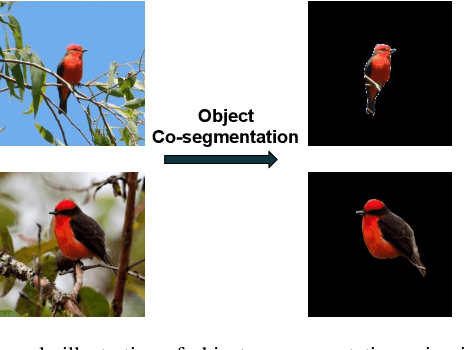

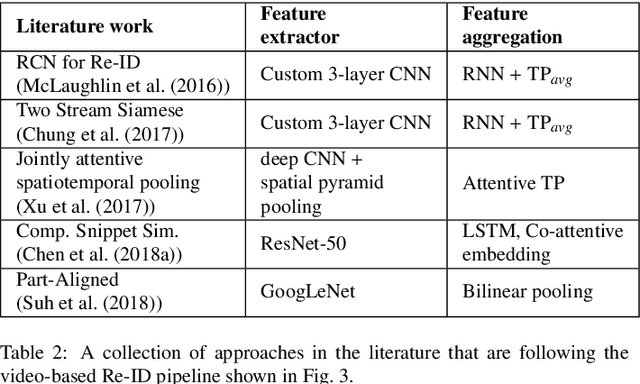
Abstract:Video-based computer vision tasks can benefit from the estimation of the salient regions and interactions between those regions. Traditionally, this has been done by identifying the object regions in the images by utilizing pre-trained models to perform object detection, object segmentation, and/or object pose estimation. Though using pre-trained models seems to be a viable approach, it is infeasible in practice due to the need for exhaustive annotation of object categories, domain gap between datasets, and bias present in pre-trained models. To overcome these downsides, we propose to utilize the common rationale that a sequence of video frames capture a set of common objects and interactions between them, thus a notion of co-segmentation between the video frame features may equip the model with the ability to automatically focus on salient regions and improve underlying task's performance in an end-to-end manner. In this regard, we propose a generic module called "Co-Segmentation Activation Module" (COSAM) that can be plugged into any CNN to promote the notion of co-segmentation based attention among a sequence of video frame features. We show the application of COSAM in three video-based tasks namely: 1) Video-based person re-ID, 2) Video captioning, & 3) Video action classification, and demonstrate that COSAM is able to capture salient regions in the video frames, thus leading to notable performance improvements along with interpretable attention maps.
Face Age Progression With Attribute Manipulation
Jun 14, 2021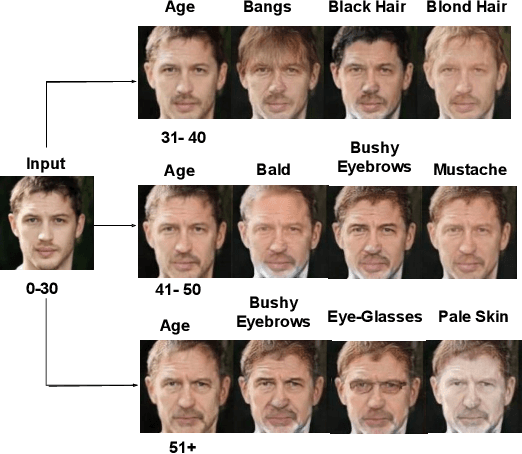
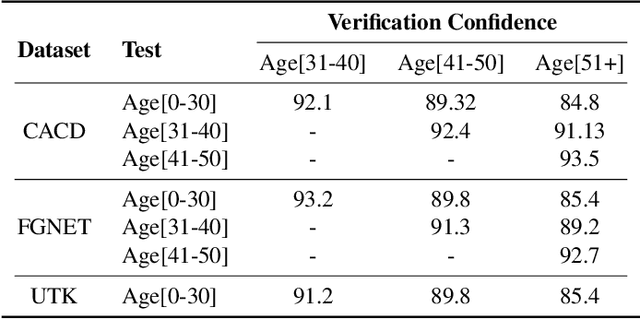
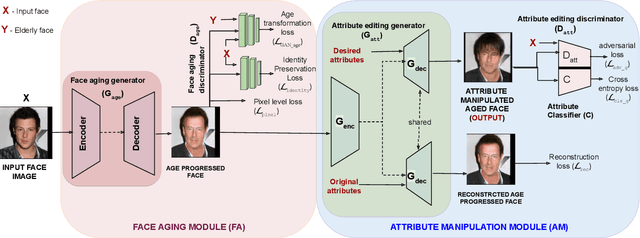
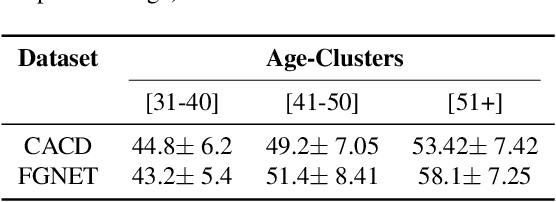
Abstract:Face is one of the predominant means of person recognition. In the process of ageing, human face is prone to many factors such as time, attributes, weather and other subject specific variations. The impact of these factors were not well studied in the literature of face aging. In this paper, we propose a novel holistic model in this regard viz., ``Face Age progression With Attribute Manipulation (FAWAM)", i.e. generating face images at different ages while simultaneously varying attributes and other subject specific characteristics. We address the task in a bottom-up manner, as two submodules i.e. face age progression and face attribute manipulation. For face aging, we use an attribute-conscious face aging model with a pyramidal generative adversarial network that can model age-specific facial changes while maintaining intrinsic subject specific characteristics. For facial attribute manipulation, the age processed facial image is manipulated with desired attributes while preserving other details unchanged, leveraging an attribute generative adversarial network architecture. We conduct extensive analysis in standard large scale datasets and our model achieves significant performance both quantitatively and qualitatively.
 Add to Chrome
Add to Chrome Add to Firefox
Add to Firefox Add to Edge
Add to Edge